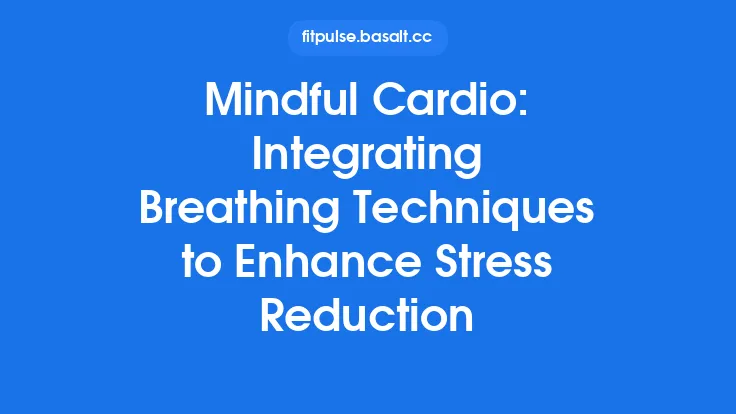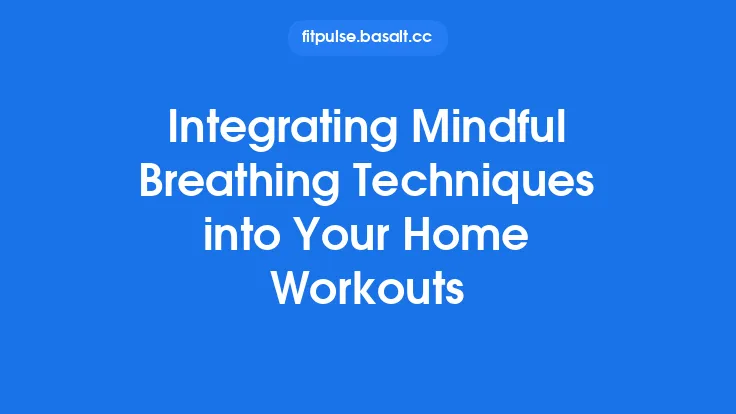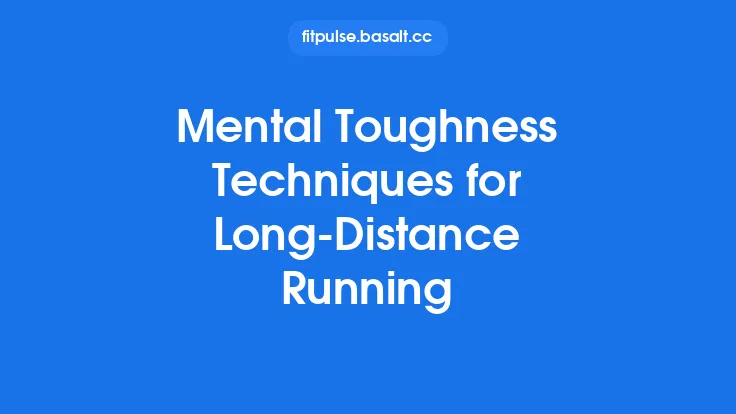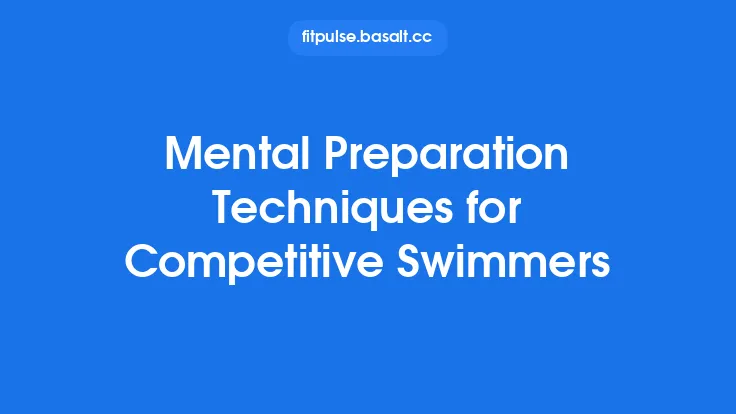Mindful breathing is one of the simplest yet most powerful tools we have for managing everyday stress. By intentionally directing attention to the breath, we can calm the nervous system, improve focus, and create a sense of grounding that carries over into all aspects of life—from the office desk to the training floor. This article explores the physiology behind breathing, outlines a variety of evidence‑based techniques, and provides practical guidance for integrating mindful breath work into a daily routine.
The Science of Breath and Stress Regulation
When we encounter a stressor, the body’s autonomic nervous system (ANS) shifts toward the sympathetic branch—often described as the “fight‑or‑flight” response. This activation releases catecholamines (adrenaline, noradrenaline) and cortisol, raising heart rate, blood pressure, and muscle tension. Simultaneously, the parasympathetic branch, responsible for “rest‑and‑digest,” is suppressed.
Breathing sits at the intersection of these two systems. Unlike most physiological processes, respiration is both involuntary and voluntarily controllable. By deliberately slowing and deepening the breath, we can stimulate the vagus nerve—a key conduit of parasympathetic activity. Vagal activation leads to:
- Reduced heart rate variability (HRV) fluctuations – a marker of increased resilience to stress.
- Lowered cortisol output – helping to prevent the chronic hormonal cascade that impairs recovery.
- Enhanced baroreflex sensitivity – improving blood pressure regulation.
Research using functional MRI and electroencephalography (EEG) shows that focused breathing modulates activity in the prefrontal cortex (PFC) and the amygdala, regions implicated in emotional regulation and threat detection. Strengthening the PFC‑amygdala connection through regular breath practice can therefore blunt the intensity of stress responses over time.
Core Principles of Mindful Breathing
- Awareness – Observe the breath without judgment. Notice the sensation of air entering the nostrils, expanding the ribcage, and exiting the body.
- Control – Adjust the rhythm, depth, or pattern of breathing intentionally.
- Consistency – Practice regularly to embed the neural pathways that support calmness.
- Integration – Apply breath cues during moments of tension, not just in isolated sessions.
These principles form the foundation for any technique discussed below.
Foundational Technique: Diaphragmatic (Abdominal) Breathing
Purpose: Activates the diaphragm, maximizes lung capacity, and promotes parasympathetic tone.
Steps:
- Sit or lie down with a straight spine. Place one hand on the chest and the other on the abdomen.
- Inhale slowly through the nose for a count of 4, directing the breath so the abdomen rises while the chest remains relatively still.
- Pause briefly (1–2 seconds) at the top of the inhale.
- Exhale gently through pursed lips for a count of 6–8, allowing the abdomen to fall.
- Repeat for 5–10 cycles, focusing on the rise and fall of the belly.
Technical note: The 4:6–8 ratio (inhale:exhale) lengthens the exhalation, which is the phase most associated with vagal activation. Over time, practitioners often find the ratio can be extended to 1:2 (e.g., 5 seconds inhale, 10 seconds exhale) without discomfort.
Technique 1: Box Breathing (Square Breathing)
Purpose: Provides a structured rhythm that is easy to remember and can be performed discreetly in any setting.
Pattern: Inhale → Hold → Exhale → Hold, each for an equal count.
Steps:
- Choose a comfortable count (e.g., 4 seconds). Adjust based on personal comfort; beginners may start with 3 seconds.
- Inhale through the nose for the chosen count, filling the lungs completely.
- Hold the breath, maintaining a relaxed diaphragm.
- Exhale slowly through the mouth or nose for the same count.
- Hold again for the same duration before beginning the next cycle.
- Perform 4–6 rounds, then return to natural breathing.
Application tip: Box breathing is especially useful before meetings, during a break in training, or when waiting in line—any moment where a quick reset is needed.
Technique 2: 4‑7‑8 Breath (Relaxing Breath)
Purpose: Leverages a longer exhalation to deepen relaxation, making it ideal for winding down before sleep.
Steps:
- Place the tip of the tongue against the ridge behind the upper front teeth (optional but recommended for airway control).
- Inhale quietly through the nose for a count of 4.
- Hold the breath for a count of 7.
- Exhale completely through the mouth, making a soft “whoosh” sound, for a count of 8.
- Repeat the cycle 3–5 times.
Physiological insight: The extended exhalation (8 counts) exceeds the typical natural exhalation length, forcing the respiratory muscles to relax further and enhancing CO₂ tolerance, which can reduce anxiety spikes.
Technique 3: Alternate Nostril Breathing (Nadi Shodhana)
Purpose: Balances hemispheric activity in the brain and promotes a sense of equilibrium.
Steps:
- Sit upright with a straight spine. Rest the left hand on the left knee, palm up.
- With the right hand, fold the index and middle fingers toward the palm, leaving the thumb, ring finger, and little finger extended.
- Close the right nostril with the thumb and inhale slowly through the left nostril for a count of 4.
- Close the left nostril with the ring finger, release the right nostril, and exhale through the right for a count of 4.
- Inhale through the right nostril for a count of 4.
- Close the right nostril, release the left, and exhale through the left for a count of 4.
- This completes one round. Perform 5–10 rounds.
Note: While this technique originates from yogic practice, its focus on breath control and bilateral stimulation makes it a valuable tool for everyday stress management without delving into performance‑specific meditation.
Technique 4: Resonant Breathing (Coherent Breathing)
Purpose: Aligns breathing with the heart’s natural rhythm to maximize heart‑rate variability (HRV) coherence.
Steps:
- Set a metronome or use a smartphone app to a tempo of 5 breaths per minute (≈6‑second inhale, 6‑second exhale).
- Inhale gently through the nose for 6 seconds, allowing the abdomen to rise.
- Exhale slowly for 6 seconds, feeling the abdomen fall.
- Continue for 5–10 minutes, maintaining a smooth, unforced rhythm.
Why 5 breaths/min? This rate coincides with the peak of HRV coherence, a state where the heart, lungs, and nervous system synchronize, producing a calm yet alert mental state.
Integrating Breath Work into Daily Life
| Situation | Recommended Technique | Duration |
|---|---|---|
| Morning wake‑up | Diaphragmatic breathing | 2–3 minutes |
| Pre‑meeting or pre‑competition | Box breathing | 1 minute (4 cycles) |
| During a break or after a stressful call | 4‑7‑8 breath | 2–3 cycles |
| Before bedtime | 4‑7‑8 breath or resonant breathing | 5–10 minutes |
| While commuting (e.g., on a bus or train) | Alternate nostril breathing (discreet) | 5 rounds |
| During a workout cooldown | Resonant breathing | 3–5 minutes |
Practical tip: Pair a breath cue with an existing habit (e.g., “after I brush my teeth, I’ll do 5 diaphragmatic breaths”). This habit stacking accelerates adoption and reduces the cognitive load of remembering to practice.
Common Pitfalls and How to Avoid Them
- Over‑breathing (hyperventilation): Trying to take overly deep or rapid breaths can lower CO₂ levels excessively, leading to light‑headedness. Stick to comfortable depths and maintain a smooth rhythm.
- Tension in the shoulders or jaw: Even while focusing on the breath, unconscious muscle tension can counteract relaxation. Perform a quick body scan before each session, releasing any tightness.
- Rushing the exhale: The exhalation phase is the primary driver of parasympathetic activation. If you find yourself cutting it short, consciously lengthen it by counting or using a metronome.
- Inconsistent practice: Benefits accrue cumulatively. Set a realistic schedule (e.g., 5 minutes twice daily) rather than occasional long sessions.
Measuring Progress Without Gadgets
While heart‑rate monitors and HRV apps can provide quantitative feedback, simple self‑assessment tools are equally valuable:
- Subjective Stress Rating: At the start and end of each day, rate perceived stress on a 0‑10 scale. Look for a gradual downward trend.
- Sleep Quality Log: Note how quickly you fall asleep and how rested you feel in the morning. Improved breath work often correlates with better sleep.
- Recovery Journal: Record moments when you felt “reset” after a breathing session—this reinforces the habit loop.
Advanced Exploration: Breath‑Induced Neuroplasticity
Repeated mindful breathing not only modulates immediate autonomic responses but also induces longer‑term changes in brain structure and function. Studies using diffusion tensor imaging (DTI) have shown increased white‑matter integrity in the corpus callosum and the anterior cingulate cortex after an 8‑week breath‑training program. These changes support enhanced emotional regulation and attentional control—key components of sustainable stress resilience.
Takeaway: Even though the focus of this article is daily stress relief, the cumulative effect of consistent breath practice can contribute to a more adaptable nervous system, indirectly supporting overall recovery and injury prevention.
Building a Personal Breath Routine
- Identify Stress Hotspots: Pinpoint times of day when stress spikes (e.g., early morning, post‑training, before bedtime).
- Select Two Core Techniques: Choose one quick technique (Box breathing) for on‑the‑spot use and one longer technique (Resonant breathing) for dedicated sessions.
- Set a Cue: Use an environmental trigger (phone alarm, coffee break) to remind you to breathe.
- Track Consistency: Mark each session on a calendar or habit‑tracking app.
- Review Monthly: Reflect on stress ratings, sleep quality, and any physical sensations (e.g., reduced muscle tension). Adjust duration or technique as needed.
Frequently Asked Questions
Q: Can I practice mindful breathing while exercising?
A: Yes. During low‑intensity cardio (e.g., walking, light cycling), you can incorporate diaphragmatic breathing to maintain a steady rhythm. For high‑intensity intervals, focus on natural breath patterns to meet oxygen demands, then transition to a calming technique during the recovery phase.
Q: Is it safe to hold my breath for extended periods?
A: The breath‑holding phases in techniques like 4‑7‑8 are modest (7‑second holds) and generally safe for healthy adults. Individuals with cardiovascular or respiratory conditions should consult a healthcare professional before incorporating prolonged holds.
Q: How does mindful breathing differ from meditation?
A: Mindful breathing is a specific, breath‑focused practice that can be completed in minutes and used as a tool for immediate stress regulation. Meditation often involves broader attentional frameworks (e.g., open monitoring, loving‑kindness) and may require longer, dedicated sessions. Both share common mechanisms but serve distinct purposes.
Q: Will breath work replace other recovery strategies?
A: No. Breath techniques complement nutrition, sleep hygiene, mobility work, and psychological strategies. Think of breathing as a low‑cost, portable “reset button” that enhances the effectiveness of other recovery modalities.
Closing Thoughts
Stress is an inevitable part of modern life, but the way we respond to it is largely within our control. By mastering a handful of mindful breathing techniques and weaving them into daily routines, we can tap into the body’s innate capacity for self‑regulation. The result is not only a calmer mind but also a more resilient nervous system—an essential foundation for optimal recovery, injury prevention, and sustained performance in any arena.





